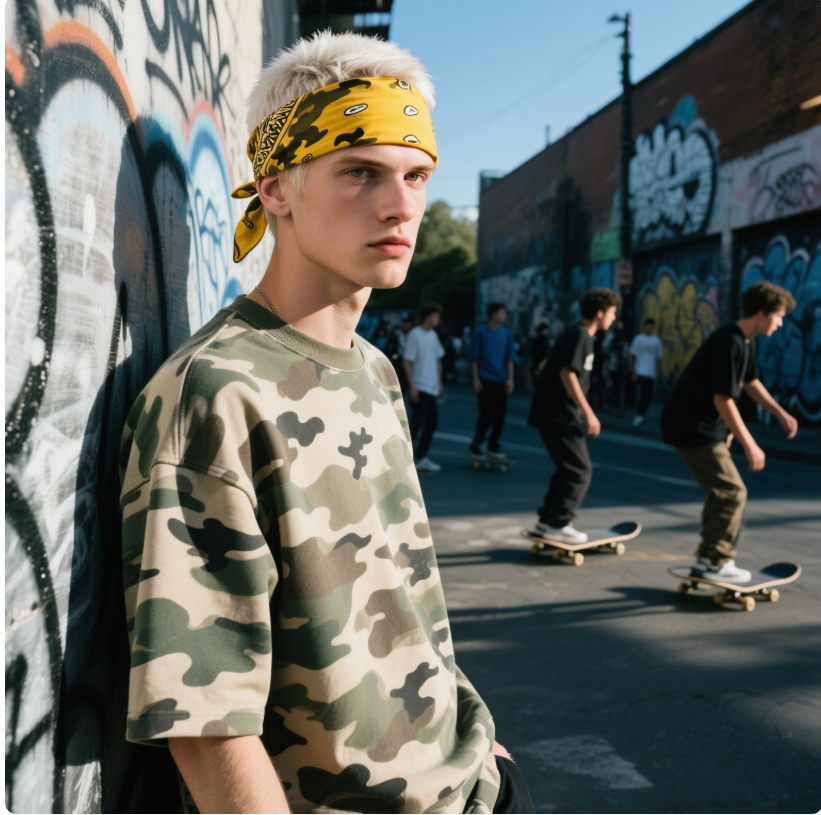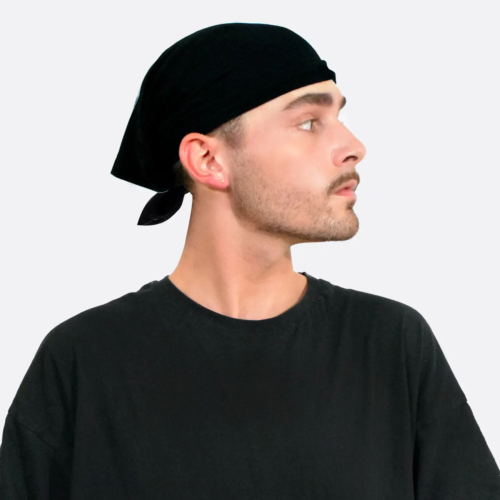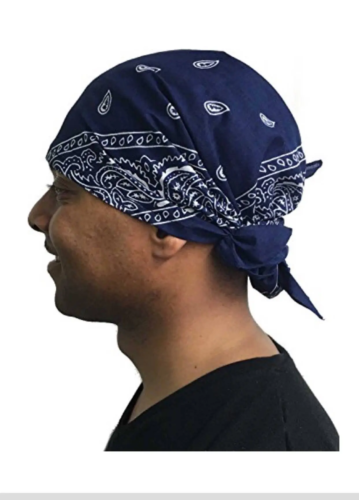Table of Contents
Toggle1. What Is a Bandana?
Bandana is a piece of cloth that is mostly square, usually made of cotton or polyester, silk satin and other materials. It is light and breathable, soft and comfortable to the touch. The paisley pattern is the most classic design. It can be tied on the head for sun protection, around the neck for warmth, tied on the wrist for decoration, and even used as a temporary mask when there is a lot of dust or wind.

Most bandanas come in a standard size of 22×22 inches, which is just enough to easily wrap around your head or neck. There are also slightly smaller or larger versions, such as those for children, pets, or wide and versatile.
bandana vs. scarf, headscarf, handkerchief, what is the difference?
You may be curious, isn’t this just a scarf or a handkerchief? In fact, they are really different:
Scarf (Scarf) is usually longer and thicker, used for warmth or as a decoration, and is used more in winter.
Headscarf (Headscarf) is mostly designed for the head, and the style is more traditional or religious.
Handkerchief (Handkerchief) is generally smaller in size, used to wipe sweat and hands, and is more functional.
Bandana combines practicality and style. It can be used as an accessory and can be used in emergencies. It is very flexible and suitable for all styles of men, women, young and old.
2.The Origin and History of Bandanas
You may think that bandanas are only standard for street fashion, but they have a richer history than you think.
The word bandana actually comes from the Indian language “bandhnū”, which means tie-dyeing, an ancient hand-dying technique. This technique forms a unique pattern by tying knots and tying fabrics before dyeing. It became popular in India and Central Asia hundreds of years ago. At that time, its usage and meaning were relatively simple.
How did it go to the world?
In the 18th century, British colonists brought this patterned fabric back to Europe, which aroused great interest. Soon after, Europe began to mass-produce similar cloth towels and exported them to America as decorations. American workers, farmers, and cowboys first used bandanas for practical scenarios, such as blocking dust, wiping sweat, and shading. It gradually changed from a “tool” to a “symbol” – representing labor, freedom, and even rebellious spirit.
In each era, bandanas say different things
In the early 20th century, red bandanas became a symbol of resistance in the workers’ movement;
In the 1960s and 1970s, hippies used bandanas to express their individuality and anti-mainstream;
Since the 1990s, hip-hop culture and street trends have pushed bandanas onto the fashion stage,
Bandanas of different colors have begun to represent different “circles” and attitudes in subcultures;
Today, it has long become a multifunctional fashion item that transcends gender, age, and culture.
3.Symbolic Meanings of Bandanas
Bandanas are not only a fashion accessory, they can also “speak”. From the color you choose to the position you wear it, bandanas can represent your identity, position, and even an attitude. Yes, behind a small piece of cloth, there are actually many people who are seriously “interpreting”.

Different colors convey different signals
You may not have noticed that the color of the bandana actually has meaning, especially in street culture or specific communities:To learn more about the meaning of colors, click on the link
🔴 Red bandana: strength, courage, and sometimes related to street gangs
🔵 Blue bandana: calmness, faith, and also symbolic meanings of specific cultures
🟢 Green bandana: nature, balance, and some countries also use it to symbolize freedom or independence
⚫ Black bandana: rebellious, independent spirit, very common in punk and gothic styles
🌈 Color bandan: diverse and inclusive, especially in the LGBTQ+ community, representing Pride and self-identity
So when choosing a bandana, in addition to seeing whether the color matches your clothes, you might as well think about this: this color may be quietly expressing part of your personality.
Street culture: Bandana is your “business card”
In street culture, bandana is never just a styling prop. For example, in hip-hop,skateboarding, and motorcycle culture, different ways of wearing, colors, and even folding styles may represent which circle you belong to, what attitude you support, or express a lifestyle.
It can be tied on the head, as if saying “I have an attitude”;
Tied on the trouser pocket, it may represent a certain team;
Hanging around the neck, sometimes it is a tribute to classic culture.
That’s why on the street, a bandana can become the language of “tacit dialogue” between you and others.
It also belongs to everyone who speaks for themselves
You may not have thought that bandanas have also played an important role in many social movements:
In the workers’ movement, red bandanas represent solidarity and struggle;
In the LGBTQ+ community, rainbow bandanas or specific colors are used to identify self-identity (such as Handkerchief Code);
At music festivals, protests, or festival parades, bandanas are fashionable tools to express attitudes and positions.
So, whether you are looking for style, attitude, or to express your stance, a Bandana can help you say what you don’t need to say.
4.Bandanas in Fashion and Pop Culture
If you think that bandanas are just functional pieces of cloth, then you may have missed their “moment of becoming a god” in the fashion circle. From Hollywood stars to street fashionistas, from hip-hop singers to fashion brands, bandanas have long been more than just accessories, but also a symbol of pop culture.

Stars + bandana = fashion trend maker
You may not realize that many celebrities you are familiar with have made bandana popular:
Tupac Shakur: The look of tying a red bandana behind his head has become a street classic;
Rihanna and A$AP Rocky: Wearing Bandanas to look high-end and fashionable, appearing on magazine covers;
Harry Styles: Boldly mixing and matching at concerts and on the red carpet, giving retro bandanas a new lease of life;
Even Lady Gaga uses bandana to convey power and style in her MV.
These pop idols tell us with their actions: bandana are not small accessories, but style statements.
Different styles, different matches, bandanas are never picky
No matter what style you go for, you can always find a bandana that suits you:
🎤 Hip-hop style: tie it on your head, cover the lower half of your face, or hang it directly on your pants chain, cool and stylish;
🤠 Denim style: match it with a denim jacket or boots, and wrap it around your neck, retro and practical;
🕶️ Retro/nostalgic style: tie the bandana into a headband or bow, and match it with sunglasses to give it a 70s feel;
🌿 Minimalist style: choose a solid color bandana, match it with a simple outfit, and add a touch of highlights to the overall look.
Whether you are bold or low-key, a bandana can be your style assistant.
Many high-end brands and independent designers have already taken bandana to new heights:
Gucci, Dior, and Louis Vuitton have all launched limited edition bandanas that combine traditional patterns with high-end materials;
Street brands such as Supreme, Off-White, and BAPE have incorporated bandana elements into T-shirts, hats, and shoes;
There are also some environmentally friendly brands that design bandanas with recycled fabrics to advocate sustainable fashion.
You can see it in trendy stores, boutiques, vintage markets, and even designer runways. The bandana has been upgraded from an “accessory” to a “fashion topic.”
5.Cultural Appropriation vs. Appreciation
Bandanas may look simple, but they have a deep cultural background. If you like to use bandanas for styling, this section is very important. You need to know when you are “appreciating culture” and when you may accidentally “appropriate culture”.
A bandana also has cultural belonging
You may not have thought that the pattern, wearing method and color of the bandana have specific meanings in many cultures:
In India, bandanas are derived from the “Bandhnū” tradition and are part of the dyeing culture;
In the African American community, bandanas are sometimes related to struggle and identity;
In Latin American and indigenous cultures, there are also unique headscarf styles and uses;
In the LGBTQ+ community, certain colors of bandanas even have clear “identity codes”.
So, when you wear it, it’s not just “good-looking” – you may also be touching the cultural symbols of a certain group.
How to wear it so that you don’t step on thunder?
Don’t worry, the key is not whether you can wear it, but whether you fully understand its cultural background. Before using a design with a cultural background, check its origin and meaning; remember not to imitate religious or traditional clothing as a styling joke; if you share your outfit photos, you can also tell the story behind the bandana. This is the best way to appreciate culture. The beauty of a bandana lies not only in its color and pattern, but also in its ability to transcend time and ethnicity, becoming a way to express oneself and respect diversity. You can use it to tell your own story – but don’t forget that it also carries other people’s memories and identities.
FAQs: Bandana Meaning, Use & More
1. What does the color of the bandana represent?
The color of the bandana not only affects the overall match, but sometimes also carries a specific cultural or community symbolic meaning. Here are some common colors that represent the meaning: Click this link to learn more
Red bandana: vitality, enthusiasm, but also a gang symbol in some street culture
Blue bandana: calm, loyal, and may also be related to a specific community
Black bandana:: independent, cool, suitable for punk and rock styles
Green bandana: natural, retro style, often seen in neutral wear
Colorful/patterned bandana:: diverse, free, especially in the LGBTQ+ circle
2. Who is the bandana suitable for?
The answer is simple:bandana are suitable for everyone!
👩🦰 Girls can use it to tie their hair, make headwear, or wrap around their necks to add layers to their looks;
👨 Boys can wear it on their heads, wrists, or bags to show their personality;
👶 Children can also choose soft mini versions, which are both cute and practical;
🐶 Even pets have exclusive versions, so you can transform into a trendy outfit with them.
3. How to choose a bandana that suits you?
It’s not difficult to choose a bandana, just remember three key points
✔️ Purpose: Do you want to wear it on your head? Around your neck? On your bag? Different purposes require different choices of material and size;
✔️ Pattern/color: Choose a pattern that suits your skin tone and style, such as retro Paisley, modern geometry, simple solid color, etc.;
✔️ Material: Cotton and tulle are recommended in summer; flannel or double-layer fabrics can be chosen for warmth in winter.



